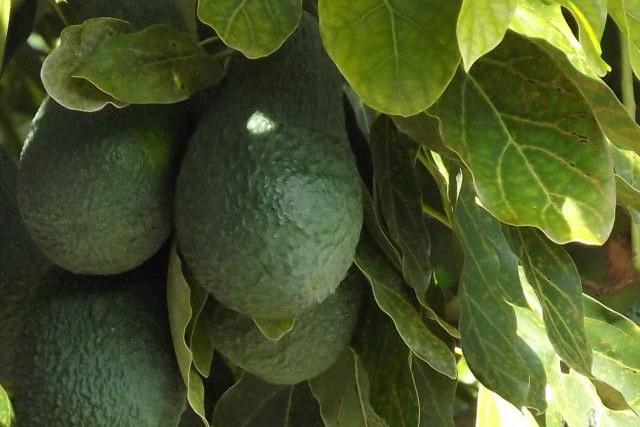Originally from Mexico, Colombia and Venezuela. This fruit was given the name of “pear of the Indies” by the first Spaniards that reached the Americas, due its external similarity with Spanish pears. Currently the main producers of this fruit are: Mexico, Brazil, USA, Australia, Israel, China, Kenya, South Africa and Spain.
Description and Characteristics:
The avocado belongs to the lauraceae family. It began to be cultivated on the Tropical Coast in 1960, hugely expanding during the decade of 1980, this crop now occupies approximately 2800 Hectares along the Granada Coast.
This evergreen tree has alternating, peduncular and very shinny leaves, known for being extremely robust and can reach up to 30 metres in height. The flowers are in sub terminal clusters; however, each flower opens in two different and separate moments, that is to say that the female and male organs are functional at different times, avoiding self-fertilization. For this reason, the varieties are classified based on the behaviour of the inflorescence that can be of two types: A and B. In both cases, the flowers open first as female, they close for a fixed period and then they open as male during their second opening/flowering. This characteristic of the avocado flowers is very important in a plantation, as for the production to be as expected it is very important to mix varieties adapted to the same altitude, of A and B flowering types and with the same flowering period in a 4:1 ratio, where the largest plantation is of the desired variety (The type of flowering of each type can be seen in the table). Each tree can produce up to a million flowers and only 0,1% develop into fruit, as a large amount of flowers and fruits fall off during their growth. This fruit has only one stone, oval with a smooth or bumpy skin. The changing of colour only occurs with certain varieties and the ripening of the fruit does not occur until the fruit is separated from the tree.
The main varieties of avocado are:
- “Bacon” of Californian in origin, its skin is smooth and bright green and it is oval shaped. The average weight of the fruit is 240 gr., representing 10 % of Spain´s production.
- “Fuerte” of Mexican origin, it has a darker green skin. It can be considered the “original” avocado. The average weight of the fruit is 260 gr., representing 65 % of the Spain’s production.
- “Hass” can be considered the most commercial variety, for being the most sought-after and is the variety that is most grown in Spain. Bumpy-skinned and dark-coloured when ripe. It has an excellent quality taste. The average weight of the fruit is 220 gr., representing 10 % of Spain’s production.
Other varieties grown in our area are “Pinkerton” and “Reed”, whose production are symbolic representing 2 and 3 % respectively.
NUTRITIONAL VALUE:
The avocado lacks a characteristic sweet or acid taste, which means it can be combined with many dishes. The optimal time for its consumption is when the flesh turns lighter and it can be spread like butter.
Fats constitute the main component after water, meaning that its calorie content is high compared to other fruits. It contains a low amount of carbohydrates and even less proteins. Regarding fat content, this is mainly monounsaturated; 72 % is oleic acid, characteristic of olive oil. It is rich in minerals such as potassium, magnesium and is low in sodium. Potassium is necessary for the transmission and generation of the nerve impulse, for normal muscular activity and intervenes in the water balance inside and outside the cell. Magnesium helps the operation of the intestine, nerves and muscles, it is a component of bones and teeth, it enhances immunity and has a mild laxative effect. Its vitamin E content can be highlighted (antioxidant, it intervenes in the stability of the blood cells and fertility) and certain water soluble B group vitamins, such as B6 or pyridoxine, which helps the correct functioning of the nervous system.
Areas where avocado is grown in Motril:
Minasierra hillsides, Panata, Montecastillo, Galindo and hillsides around Puntalón, Torrenueva and higher hillsides in Carchuna.

